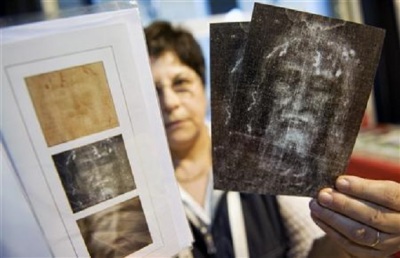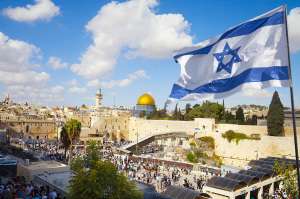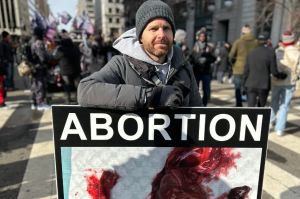The Question of the Shroud's Authenticity and the Certainty of the Resurrection's Historicity

A recent article on Newsmax broke the news that according to a new study, the Shroud of Turin was deemed a fake, most likely originated in medieval times. According to a recent study, scientists used bloodstain pattern analysis (BPA) by placing tubes into the wrists of a volunteer to simulate the dripping of blood as well as in the place where the sword entered the side. The experiment did not match the blood stains as found on the cloth. The author of the article appeals to a 1988 carbon dating test that dated the cloth to medieval times.
I am quite skeptical of this test. I feel there are several reasons to doubt the findings and the conclusions in the article. First, my understanding is that droplets of blood were used in this test. Small droplets of blood do not account for the massive amount of blood that would have been lost after Jesus would have been taken from the cross. Second, the Shroud, if authentic, would not have necessarily remained in one position. It may have been that the body would have been repositioned while the blood was pouring out of the body to until it reached its final resting state. It seems that this study does not take that into account. Third, the stains on the cloth have been deemed as authentic AB hemoglobin. Thus, even if the flow of blood did not match identically to the recent test, that the stains are indeed blood, old blood at that, is nearly indisputable. Fourth, the article seems to hold to the authenticity of the 1988 carbon testing. The problem is that the fiber of the Shroud used for testing came from the patchwork used to repair the Shroud in a fire that took place in medieval times. Particles of pollen found on the cloth originate in areas found in and around Jerusalem. Many of those pollen particles date to the first-century.
I do think that the evidence for the Shroud is far more convincing than evidence against the Shroud. However, I want to emphasize that the resurrection of Jesus is not determined by the Shroud's authenticity. The Shroud would certainly help, but it is not necessary or essential to the case for the resurrection's historicity. So, how can we know that the resurrection of Jesus took place? Some have proposed an acronym RISEN to explain the evidence for the resurrection. Using the acronym, I'm going to change the terms slightly from what others have used to emphasize the historical evidences for Jesus's resurrection. I cannot give a full treatment of each detail, but I will provide a brief summary of each.
R Records of Jesus's Death and Resurrection. Jesus's death, burial, and resurrection are recorded not only in the Gospels, but there are records indicating this occurrence in the numerous writings of the early church fathers, as well as extra-biblical Roman and Jewish writings. The number and date of these testimonies bode well for the resurrection's historicity.
I Irksome Details. Some of the details of Jesus's resurrection are quite irksome and embarrassing for the early church. Why in the world would the early church have claimed Mary Magdalene as the first witness of Jesus's resurrection when a woman's testimony was not held in high-esteem? To make matters worse, Mary Magdalene could have had something of a bad past history. This is just the tip of the iceberg considering the irksome details for the early church in Jesus's resurrection event. Embarrassing details add to an event's historicity.
S Sightings of Jesus's Appearance. Jesus was not seen just once. He was seen numerous times over the course of a forty-day period. 1 Cor. 15 notes that over 500 people saw Jesus at one time. Seeing that the early creed in 1 Corinthians does not contain any female witnesses and the fact that only men were counted in public gatherings, I think the number is probably more likely around 2,000 that saw Jesus alive at one time. The number of eyewitnesses add to the depth of the resurrection's historicity.
E Early Confessions and Creeds. The New Testament is caulked full of early creeds and confessions. Some of the more prominent entries include 1 Cor. 15:3-9; Rom. 10:9; Col. 1:15-20; Phil. 2:5-11; among many others. Some of these creeds and formulations date to within 3-5 months of Jesus's resurrection (esp. 1 Cor. 15:3-9). These early creeds make the inclusion of legendary details concerning Jesus's resurrection highly unlikely as these were the teachings held by the earliest eyewitnesses.
N Newfound Faith. The transformation of Paul of Tarsus and James the brother of Jesus is legendary. These two individuals were against Jesus and his ministry until they witnessed the risen Jesus. In addition, the church changed some details of their worship in a radical fashion after Jesus's resurrection. They switched their day of worship from the Sabbath day to Sunday to commemorate Jesus's resurrection. Such transformations shout that something extraordinary took place. That extraordinary event was Jesus's resurrection.
So, while I am not convinced by the recent test contra the Shroud, I also hold that the resurrection of Jesus stands strong historically with or without the Shroud. No matter what the final verdict turns out to be concerning the Shroud, the resurrection of Jesus is, as far as I am concerned, historically verifiable.
© 2018. BellatorChristi.com.



























